Casio 5394 - OCW-P1000 Handleiding
Bekijk gratis de handleiding van Casio 5394 - OCW-P1000 (23 pagina’s), behorend tot de categorie Horloge. Deze gids werd als nuttig beoordeeld door 24 mensen en kreeg gemiddeld 4.7 sterren uit 12.5 reviews. Heb je een vraag over Casio 5394 - OCW-P1000 of wil je andere gebruikers van dit product iets vragen? Stel een vraag
Pagina 1/23

Operation Guide 5394 (OC)
E-7
2. Check the Home City.
Use the procedure under “To confi gure Home City settings” (page E-27) to confi gure your Home City.
Important!
x Proper time calibration signal reception depends on correct Home City, time, and day settings in the
Timekeeping Mode. Make sure you confi gure these settings correctly.
3. Set the current time.
x To set the time using a time calibration signal
See “To get ready for a receive operation” (page E-18).
x To set the time manually
See “Confi guring Current Time and Day Settings Manually” (page E-30).
The watch is now ready for use.
x For details about the watch’s radio controlled timekeeping feature, see “Radio Controlled Atomic
Timekeeping” (page E-16).
E-6
Things to check before using the watch
1. Hold down
B
at least two seconds to enter the Timekeeping Mode, and then observe the
movement of the
2
Second Hand.
Is the
2
Second Hand moving smoothly at one-second intervals?
Is the
2
Second Hand moving at two-second intervals
or is it stopped completely?
Go to step 2.
The watch is charged. For details about
charging, see “Charging the Watch”
(page E-11).
Power is low. Charge the watch by placing it in a
location where it is exposed to light. For details, see
“Charging the Watch” (page E-11).
NO
YES
YES
NEXT
E-5
To start HS1 high-speed movement
While the crown is pulled out, rotate it rapidly away from you (forward) or towards
you (reverse) until the desired HS1 high-speed movement starts.
To start HS2 high-speed movement
While HS1 high-speed movement is in progress, again rotate the crown rapidly,
away from you (forward) or towards you (reverse) in the same direction as the
HS1 movement until HS2 high-speed movement starts.
To stop high-speed movement
Rotate the crown in the direction that is opposite that of the current high-speed
movement or press any button.
Note
x You can use high-speed hand movement when confi guring time settings in the Timekeeping Mode,
Alarm Mode, or Countdown Timer Mode, and when adjusting day indicator alignment.
E-4
Using the Crown
Pull out the crown before rotating it.
To pull out, rotate, or push the crown in
Pull out Rotate Push in
Note
x If you do not perform any operation for more than two minutes after pulling out the crown, crown
operations will become disabled automatically. If this happens, push the crown back in and then pull it
out again to re-enable crown operations.
x Button operations may become disabled after you perform a crown operation. If this happens, rotate
the crown slightly. This should restore button operations.
High-speed Movement
When rotating the crown to move the hands of the watch, you can use the operations described below
to move the hands at high speed, either forward or back. There are two high-speed levels: HS1 and HS2
(faster than HS1).
E-3
About This Manual
Operations are performed using the watch’s crown, and the three buttons
indicated by the letters A, B and C in this manual.
Hands and Indicators
1
Hour Hand
2
Second Hand
3
Minute Hand
4
Upper Dial Hand: Indicates a time, in 24-hour format, depending on the
current mode.
5
Lower Dial Hand: Indicates the current mode.
6
Day Indicator
This User’s Guide uses numbers shown above to identify watch hands and
indicator.
E-2
Applications
This watch has built-in sensors that measure direction.
Measurement results are indicated by the watch’s hands and displays. This feature makes this watch
useful when hiking, mountain climbing, or when engaging in other such outdoor activities.
Warning!
x The measurement functions built into this watch are not intended for taking measurements that
require professional or industrial precision. Values produced by this watch should be considered as
reasonable representations only.
x When engaging in mountain climbing or other activities in which losing your way can create a
dangerous or life-threatening situation, always use a second compass to confi rm direction readings.
x Note that CASIO COMPUTER CO., LTD. assumes no responsibility for any damage or loss suffered
by you or any third party arising through the use of this product or its malfunction.
Important!
x Whenever you use the digital compass of this watch for serious trekking, mountain climbing, or
other activities, always be sure to take along another compass to confi rm readings. If the readings
produced by the digital compass of this watch are different from those of the other compass, perform
bidirectional calibration of the digital compass to ensure more accurate readings.
x Direction readings and digital compass calibration will not be possible if the watch is in the vicinity of
a permanent magnet (magnetic accessory, etc.), metal objects, high-voltage wires, aerial wires, or
electrical household appliances (TV, computer, cellphone, etc.)
E-1
ENGLISH
Congratulations upon your selection of this CASIO watch.
x Note that the product illustrations in this manual are intended for reference only, and so the actual product
may appear somewhat different than depicted by an illustration.
This watch does not have a city code that corresponds to the UTC offset of –3.5 hours. Because of
this, the radio-controlled atomic timekeeping function will not display the correct time for Newfoundland,
Canada.
Note that CASIO COMPUTER CO., LTD. assumes no responsibility for any damage or loss suffered by
you or any third party arising through the use of your watch or its malfunction.
MA1410-EA © 2014 CASIO COMPUTER CO., LTD.

Operation Guide 5394 (OC)
E-15
Power Saving
Power Saving enters a sleep state (second hand sleep or function sleep) whenever the watch is left for a
certain period in an area where it is dark.
Elapsed Time in Dark Operation
60 to 70 minutes (second hand sleep) 2
2
Second Hand only stopped at 12 o’clock, all other functions enabled
6 or 7 days (function sleep) x All functions, including analog timekeeping, disabled
x Internal timekeeping maintained
x The watch will not enter a sleep state between 6:00 AM and 9:59 PM. If the watch is already in a sleep
state when 6:00 AM arrives, however, it will remain there.
x The watch will not enter a sleep state while it is in the Stopwatch Mode or Countdown Timer Mode.
To recover from the sleep state
Move the watch to a well-lit area or press any button.
E-14
Charging Times
Exposure Level (Brightness) Daily
Operation *1
Level Change *2
Level 3 Level 2 Level 1
Outdoor sunlight (50,000 lux) 8 minutes 2 hours 27 hours
Window sunlight (10,000 lux) 30 minutes 6 hours 99 hours
Window sunlight on cloudy day (5,000 lux) 48 minutes 10 hours 161 hours
Indoor fl uorescent lighting (500 lux) 8 hours 111 hours – – –
*1 Approximate exposure each day to generate power for normal daily operation.
*2 Approximate exposure to take power up one level.
x The above times are for reference only. Actual times depend on lighting conditions.
x For details about the operating time and daily operating conditions, see the “Power Supply” section of
the Specifi cations (page E-65).
E-13
Low Battery Alert (Hand Movement and Function Status)
Level Hand Movement Function Status
1 Normal. All functions enabled
22
2
Second Hand moves at two-second intervals. Beeper and time calibration signal reception disabled.
32
2
Second Hand stopped. All functions disabled
x When power drops to Level 3, all settings (including timekeeping) will be cleared. Recharging the
battery will reset all settings to their initial factory defaults.
x When the watch is at Level 3, exposing it to light for a while will cause the 2
2
Second Hand to move to
the position of second 57. This indicates that charging has started.
Power Recovery Mode
The watch is designed to go into a power recovery mode that stops hand operation temporarily whenever
power suddenly drops below a certain level due to continuous signal reception or other operations over a
short period. Note that all operations are disabled while the watch is in the power recovery mode.
The hands will move to the correct positions and the watch will resume normal operation after power
recovers (in about 15 minutes). Putting the watch in a location where it is exposed to light will help power
to recover sooner.
E-12
Important!
x Keep the watch in an area normally exposed to bright light when storing it for long periods. This helps
to ensure that power does not run down.
x Storing the watch for long periods in an area where there is no light or wearing it in such a way that it is
blocked from exposure to light can cause power to run down. Make sure that the watch is exposed to
bright light whenever possible.
Checking the Current Power Level
Certain functions will be disabled when the power level is low. If the power level is low, leave the watch in
a location where its face (solar panel) is exposed to light.
Low Power
Low power conditions are indicated by the movement of the
2
Second Hand in
the Timekeeping Mode.
x If the
2
Second Hand is moving normally at one-second intervals, power is
at Level 1.
x If the
2
Second Hand is moving at two-second intervals, power is at Level
2, which is quite low. Expose the watch to light as soon as possible so it
can charge.
Moves at two-second
intervals.
E-11
Charging the Watch
The face of the watch is a solar panel that generates power from light. The generated power charges a
built-in rechargeable battery, which powers watch operations. The watch charges whenever it is exposed
to light.
Charging Guide
Whenever you are not wearing
the watch, be sure to leave it in
a location where it is exposed
to light.
x Best charging performance
is achieved by exposing
the watch to light that is as
strong as possible.
When wearing the watch,
makes sure that its face is
not blocked from light by the
sleeve of your clothing.
x The watch may enter a sleep
state (page E-15) if its face is
blocked by your sleeve even
only partially.
Warning!
Leaving the watch in bright light for charging can cause it to become quite hot. Take care when
handling the watch to avoid burn injury. The watch can become particularly hot when exposed to
the following conditions for long periods.
x On the dashboard of a car parked in direct sunlight
x Too close to an incandescent lamp
x Under direct sunlight
E-10
Using the Countdown Timer . . . . . . . . . . . . . . . . . . . . . . . . . . . . . . . . . . . . . . . . . . . . . . . . . . . . . . . . .E-50
To specify the countdown start time . . . . . . . . . . . . . . . . . . . . . . . . . . . . . . . . . . . . . . . . . . . . . . . .E-50
To perform a countdown timer operation . . . . . . . . . . . . . . . . . . . . . . . . . . . . . . . . . . . . . . . . . . . . .E-51
To stop the alarm . . . . . . . . . . . . . . . . . . . . . . . . . . . . . . . . . . . . . . . . . . . . . . . . . . . . . . . . . . . . . . .E-51
Using the Alarm . . . . . . . . . . . . . . . . . . . . . . . . . . . . . . . . . . . . . . . . . . . . . . . . . . . . . . . . . . . . . . . . . . .E-52
To change the alarm time setting . . . . . . . . . . . . . . . . . . . . . . . . . . . . . . . . . . . . . . . . . . . . . . . . . .E-53
To turn the alarm on or off . . . . . . . . . . . . . . . . . . . . . . . . . . . . . . . . . . . . . . . . . . . . . . . . . . . . . . . .E-54
To stop the alarm . . . . . . . . . . . . . . . . . . . . . . . . . . . . . . . . . . . . . . . . . . . . . . . . . . . . . . . . . . . . . . .E-54
Adjusting Home Positions . . . . . . . . . . . . . . . . . . . . . . . . . . . . . . . . . . . . . . . . . . . . . . . . . . . . . . . . . .E-55
To adjust home positions . . . . . . . . . . . . . . . . . . . . . . . . . . . . . . . . . . . . . . . . . . . . . . . . . . . . . . . . .E-56
Troubleshooting . . . . . . . . . . . . . . . . . . . . . . . . . . . . . . . . . . . . . . . . . . . . . . . . . . . . . . . . . . . . . . . . . .E-57
Specifi cations . . . . . . . . . . . . . . . . . . . . . . . . . . . . . . . . . . . . . . . . . . . . . . . . . . . . . . . . . . . . . . . . . . . .E-64
E-9
Timekeeping . . . . . . . . . . . . . . . . . . . . . . . . . . . . . . . . . . . . . . . . . . . . . . . . . . . . . . . . . . . . . . . . . . . . . .E-26
Confi guring Home City Settings . . . . . . . . . . . . . . . . . . . . . . . . . . . . . . . . . . . . . . . . . . . . . . . . . . . . .E-27
To confi gure Home City settings . . . . . . . . . . . . . . . . . . . . . . . . . . . . . . . . . . . . . . . . . . . . . . . . . . .E-27
To switch between standard time and summer time manually . . . . . . . . . . . . . . . . . . . . . . . . . . . .E-29
Confi guring Current Time and Day Settings Manually . . . . . . . . . . . . . . . . . . . . . . . . . . . . . . . . . . .E-30
To change the current time setting manually . . . . . . . . . . . . . . . . . . . . . . . . . . . . . . . . . . . . . . . . . .E-30
To change the current day setting manually . . . . . . . . . . . . . . . . . . . . . . . . . . . . . . . . . . . . . . . . . .E-32
Taking Direction Readings . . . . . . . . . . . . . . . . . . . . . . . . . . . . . . . . . . . . . . . . . . . . . . . . . . . . . . . . . .E-34
To take a direction reading . . . . . . . . . . . . . . . . . . . . . . . . . . . . . . . . . . . . . . . . . . . . . . . . . . . . . . .E-35
To perform bidirectional calibration . . . . . . . . . . . . . . . . . . . . . . . . . . . . . . . . . . . . . . . . . . . . . . . . .E-40
To perform northerly calibration . . . . . . . . . . . . . . . . . . . . . . . . . . . . . . . . . . . . . . . . . . . . . . . . . . . .E-41
Checking the Current Time in a Different Time Zone . . . . . . . . . . . . . . . . . . . . . . . . . . . . . . . . . . . . .E-44
To view the time in another time zone . . . . . . . . . . . . . . . . . . . . . . . . . . . . . . . . . . . . . . . . . . . . . . .E-45
To swap your Home City and World Time City . . . . . . . . . . . . . . . . . . . . . . . . . . . . . . . . . . . . . . . .E-47
Using the Stopwatch . . . . . . . . . . . . . . . . . . . . . . . . . . . . . . . . . . . . . . . . . . . . . . . . . . . . . . . . . . . . . . .E-48
To enter and exit the Stopwatch Mode . . . . . . . . . . . . . . . . . . . . . . . . . . . . . . . . . . . . . . . . . . . . . .E-49
To perform an elapsed time operation . . . . . . . . . . . . . . . . . . . . . . . . . . . . . . . . . . . . . . . . . . . . . . .E-49
To perform fl yback timing . . . . . . . . . . . . . . . . . . . . . . . . . . . . . . . . . . . . . . . . . . . . . . . . . . . . . . . .E-49
E-8
Contents
About This Manual . . . . . . . . . . . . . . . . . . . . . . . . . . . . . . . . . . . . . . . . . . . . . . . . . . . . . . . . . . . . . . . . .E-3
Using the Crown . . . . . . . . . . . . . . . . . . . . . . . . . . . . . . . . . . . . . . . . . . . . . . . . . . . . . . . . . . . . . . . . . . .E-4
To pull out, rotate, or push the crown in . . . . . . . . . . . . . . . . . . . . . . . . . . . . . . . . . . . . . . . . . . . . . .E-4
Things to check before using the watch . . . . . . . . . . . . . . . . . . . . . . . . . . . . . . . . . . . . . . . . . . . . . . . .E-6
Charging the Watch . . . . . . . . . . . . . . . . . . . . . . . . . . . . . . . . . . . . . . . . . . . . . . . . . . . . . . . . . . . . . . . .E-11
To recover from the sleep state . . . . . . . . . . . . . . . . . . . . . . . . . . . . . . . . . . . . . . . . . . . . . . . . . . . .E-15
Radio Controlled Atomic Timekeeping . . . . . . . . . . . . . . . . . . . . . . . . . . . . . . . . . . . . . . . . . . . . . . . .E-16
To get ready for a receive operation . . . . . . . . . . . . . . . . . . . . . . . . . . . . . . . . . . . . . . . . . . . . . . . .E-18
To perform manual receive . . . . . . . . . . . . . . . . . . . . . . . . . . . . . . . . . . . . . . . . . . . . . . . . . . . . . . .E-20
To check the result of the latest receive operation . . . . . . . . . . . . . . . . . . . . . . . . . . . . . . . . . . . . .E-21
To turn auto receive on and off . . . . . . . . . . . . . . . . . . . . . . . . . . . . . . . . . . . . . . . . . . . . . . . . . . . .E-22
Mode Reference Guide . . . . . . . . . . . . . . . . . . . . . . . . . . . . . . . . . . . . . . . . . . . . . . . . . . . . . . . . . . . . .E-24
To determine the watch’s current mode . . . . . . . . . . . . . . . . . . . . . . . . . . . . . . . . . . . . . . . . . . . . .E-25
To select a mode . . . . . . . . . . . . . . . . . . . . . . . . . . . . . . . . . . . . . . . . . . . . . . . . . . . . . . . . . . . . . . .E-25
To return to the Timekeeping Mode from any other mode . . . . . . . . . . . . . . . . . . . . . . . . . . . . . . .E-25

Operation Guide 5394 (OC)
E-23
Radio-controlled Atomic Timekeeping Precautions
x Strong electrostatic charge can result in the wrong time setting.
x Even if a receive operation is successful, certain conditions can cause the time setting to be off by up
to one second.
x The watch is designed to update its day setting automatically for the period from January 1, 2000
to December 31, 2099. Updating of the day setting by signal reception will no longer be performed
starting from January 1, 2100.
x If you are in an area where signal reception is not possible, the watch keeps time with the precision
noted in “Specifi cations” (page E-64).
x The receive operation is disabled under any of the following conditions.
− While power is at Level 2 or lower (page E-13)
− While the watch is in the power recovery mode (page E-13)
− While the watch is in the function sleep state (power saving, page E-15)
− While the watch is not in the Timekeeping Mode
− While a direction reading or Countdown Timer operation is in progress (even if the watch is in the
Timekeeping Mode)
x A receive operation is cancelled if an alarm sounds while it is being performed.
E-22
To turn auto receive on and off
1. In the Timekeeping Mode, press C. The
2
Second Hand will move to
Y (YES) or N (NO) to indicate the last calibration signal receive result.
2. Pull out the crown.
x The
2
Second Hand will perform one full revolution and then stop at the
current on/off setting.
3. Rotate the crown to move the
2
Second Hand to the setting you want.
x To turn on auto receive, select Y (YES).
x To turn off auto receive, select N (NO).
4. Push the crown back in to exit the auto receive on and off setting mode.
x If you do not perform any operation with the crown for about two minutes
after pulling it out, crown operations will become disabled. If this
happens, push the crown back in and then pull it out again.
Y (YES)
N (NO)
E-21
To check the result of the latest receive operation
In the Timekeeping Mode, press C. The
2
Second Hand will move to Y (YES)
or N (NO) to indicate the last calibration signal receive result.
x The
2
Second Hand will move to Y if the latest receive operation was
successful, or N if it was not. After about 10 seconds, regular timekeeping
will resume.
x Press C to return to regular timekeeping. The watch will also return
to regular timekeeping if you do not perform any operation for about
10 seconds.
Note
x The
2
Second Hand will indicate N if you have adjusted the time or day
setting manually since the latest receive operation.
E-20
To perform manual receive
1. In the Timekeeping Mode (page E-26), keep C depressed (for about two seconds) as the
2
Second Hand
goes through the following sequence.
x Moves to Y (YES) or N (NO) to indicate the last signal reception result, then to R (READY).
2. The
2
Second Hand indicates the operations the watch is currently performing.
When the 2
2
Second Hand is
pointed here: It means this:
R (READY)
Watch is setting up for reception.
W (WORK) Reception is in progress.
x If signal reception is unstable, the 2
2
Second Hand may move between
W and R.
x When the receive operation is successful, the watch adjusts the time
setting accordingly, and then resumes regular timekeeping. It does not
adjust the setting if the operation failed.
Note
x To interrupt a receive operation and return to the Timekeeping Mode, press
any button.
E-19
x Signal reception may be diffi cult or even impossible under the conditions described below.
Inside or among
buildings
Inside a vehicle Near household
appliances,
offi ce
equipment, or a
mobile phone
Near a
construction
site, airport, or
other sources of
electrical noise
Near
high-tension
power lines
Among or behind
mountains
3. What you should do next depends on whether you are using Auto Receive or Manual Receive.
x Auto Receive: Leave the watch over night in the location you selected in step 2. See “Auto Receive”
on page E-19 for details.
x Manual Receive: Perform the operation under “To perform manual receive” on page E-20.
Auto Receive
x With Auto Receive, the watch performs the receive operation each day automatically up to six times (up
to fi ve times for the Chinese calibration signal) between the hours of midnight and 5 a.m. (according
to the Timekeeping Mode time). When any receive operation is successful, none of the other receive
operations for that day are performed.
x When a calibration time is reached, the watch will perform the receive operation only if it is in the
Timekeeping Mode. The receive operation is not performed if a calibration time is reached while you
are confi guring settings.
E-18
x Signal reception may not be possible at the distances noted below during certain times of the year or
day. Radio interference may also cause problems with reception.
− Mainfl ingen (Germany) or Anthorn (England) transmitters: 500 kilometers (310 miles)
− Fort Collins (United States) transmitter: 600 miles (1,000 kilometers)
− Fukushima or Fukuoka/Saga (Japan) transmitters: 500 kilometers (310 miles)
− Shangqiu (China) transmitter: 500 kilometers (310 miles)
x As of June 2014, China does not use Daylight Saving Time (DST). If China does go to the Daylight
Saving Time system in the future, some functions of this watch may no longer operate correctly.
x Using this watch in a country covered by a time calibration signal that is different from the countries it
supports may result in incorrect time indication due to local application of daylight saving time (summer
time), etc.
To get ready for a receive operation
1. Confi rm that the watch is in the Timekeeping Mode. If it isn’t, hold down B for at least two seconds to
enter the Timekeeping Mode.
2. Place the watch in a location where signal reception is good.
12 o’clock
or
x Position the watch as shown in the nearby illustration,
with 12 o’clock pointed towards a window. Make sure
there are no metal objects nearby.
x Signal reception normally is better at night.
x The receive operation takes from two to 10 minutes, but
in some cases it can take as long as 20 minutes. Take
care that you do not perform any button operation or
move the watch during this time.
E-17
Approximate Reception Ranges
Japanese Signals Chinese Signal
Fukushima
500 kilometers
1,000 kilometers
Fukuoka/Saga
1,500 kilometers
Changchun500 kilometers
Beijing
Shangqiu
Shanghai
Chengdu
Hong Kong
UK and German Signals North American Signal
Anthorn
500 kilometers
1,500 kilometers
Mainfl ingen
The Anthorn signal is receivable
within this area.
2,000 miles
(3,000 kilometers)
600 miles
(1,000 kilometers)
Fort Collins
E-16
Radio Controlled Atomic Timekeeping
This watch receives a time calibration signal and updates its time setting accordingly. However, when
using the watch outside of areas covered by time calibration signals, you will have to adjust the settings
manually as required. See “Confi guring Current Time and Day Settings Manually” (page E-30) for more
information.
This section explains how the watch updates its time settings when the city code selected as the Home
City is in Japan, North America, Europe, or China, and is one that supports time calibration signal
reception.
If your Home City Code setting is this: The watch can receive the signal from the transmitter
located here:
LON (LONDON), PAR (PARIS), ATH (ATHENS) Anthorn (England), Mainfl ingen (Germany)
HKG (HONG KONG) Shangqiu City (China)
TYO (TOKYO) Fukushima (Japan), Fukuoka/Saga (Japan)
HNL (HONOLULU), ANC (ANCHORAGE),
LAX (LOS ANGELES), DEN (DENVER),
CHI (CHICAGO), NYC (NEW YORK)
Fort Collins, Colorado (United States)
Important!
x The areas covered by HNL (HONOLULU) and ANC (ANCHORAGE) are quite far from the calibration
signal transmitters, so certain conditions may cause reception problems.
Product specificaties
| Merk: | Casio |
| Categorie: | Horloge |
| Model: | 5394 - OCW-P1000 |
Heb je hulp nodig?
Als je hulp nodig hebt met Casio 5394 - OCW-P1000 stel dan hieronder een vraag en andere gebruikers zullen je antwoorden
Handleiding Horloge Casio
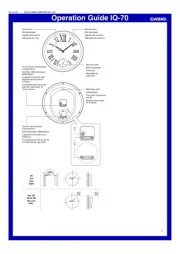
18 Juni 2025
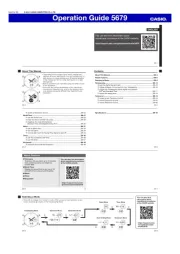
17 Juni 2025
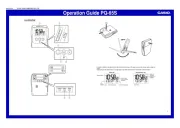
17 Juni 2025
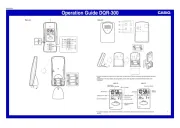
16 Juni 2025

16 Juni 2025
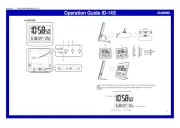
16 Juni 2025
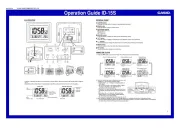
16 Juni 2025
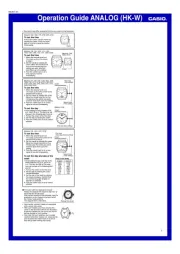
16 Juni 2025
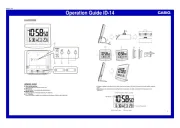
16 Juni 2025
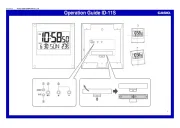
16 Juni 2025
Handleiding Horloge
- WoodWatch
- ELYSEE
- Garmin
- Fossil
- Easypix
- Breo
- Timer
- Girard-Perregaux
- Grand Seiko
- Nautica
- TW Steel
- Tissot
- Iron Annie
- BML
- MICHELE
Nieuwste handleidingen voor Horloge

5 Juli 2025

5 Juli 2025

4 Juli 2025

4 Juli 2025

4 Juli 2025

4 Juli 2025

4 Juli 2025

2 Juli 2025
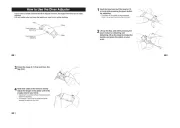
1 Juli 2025

21 Juni 2025